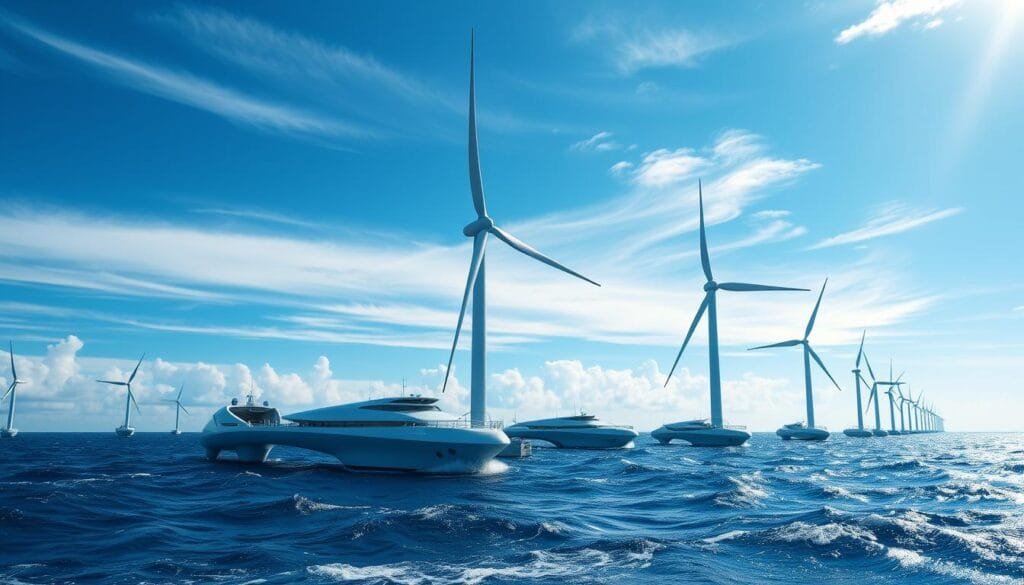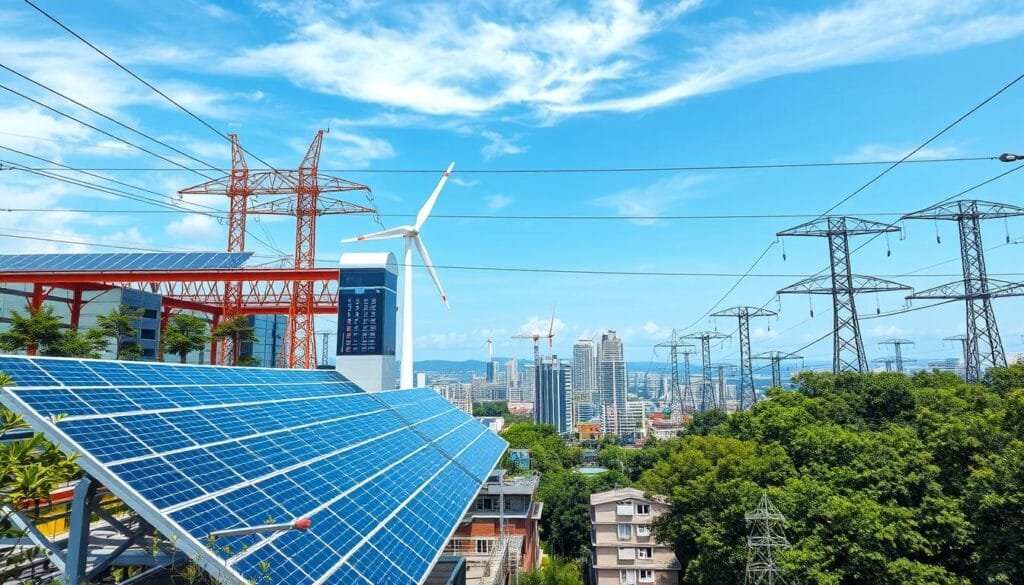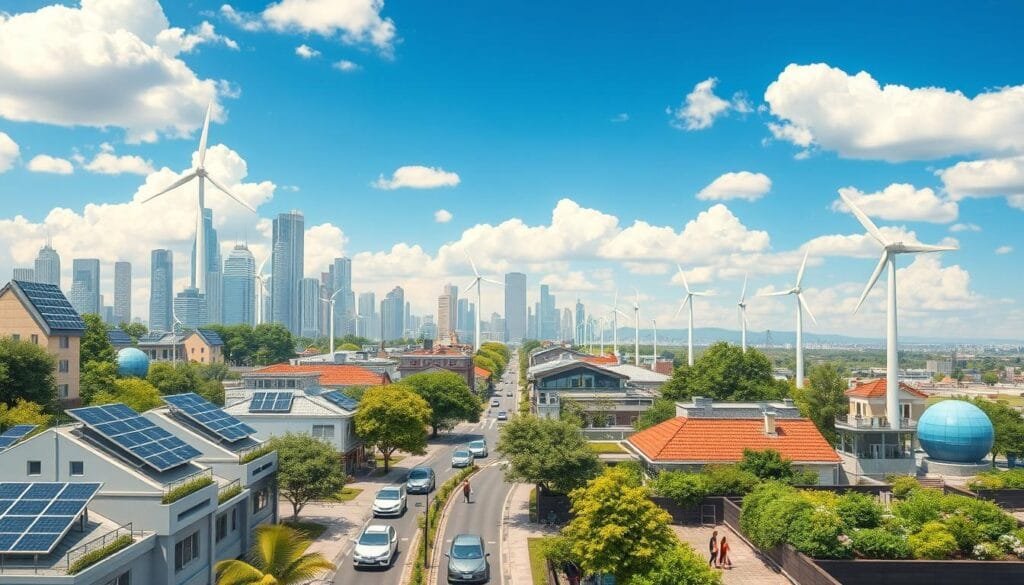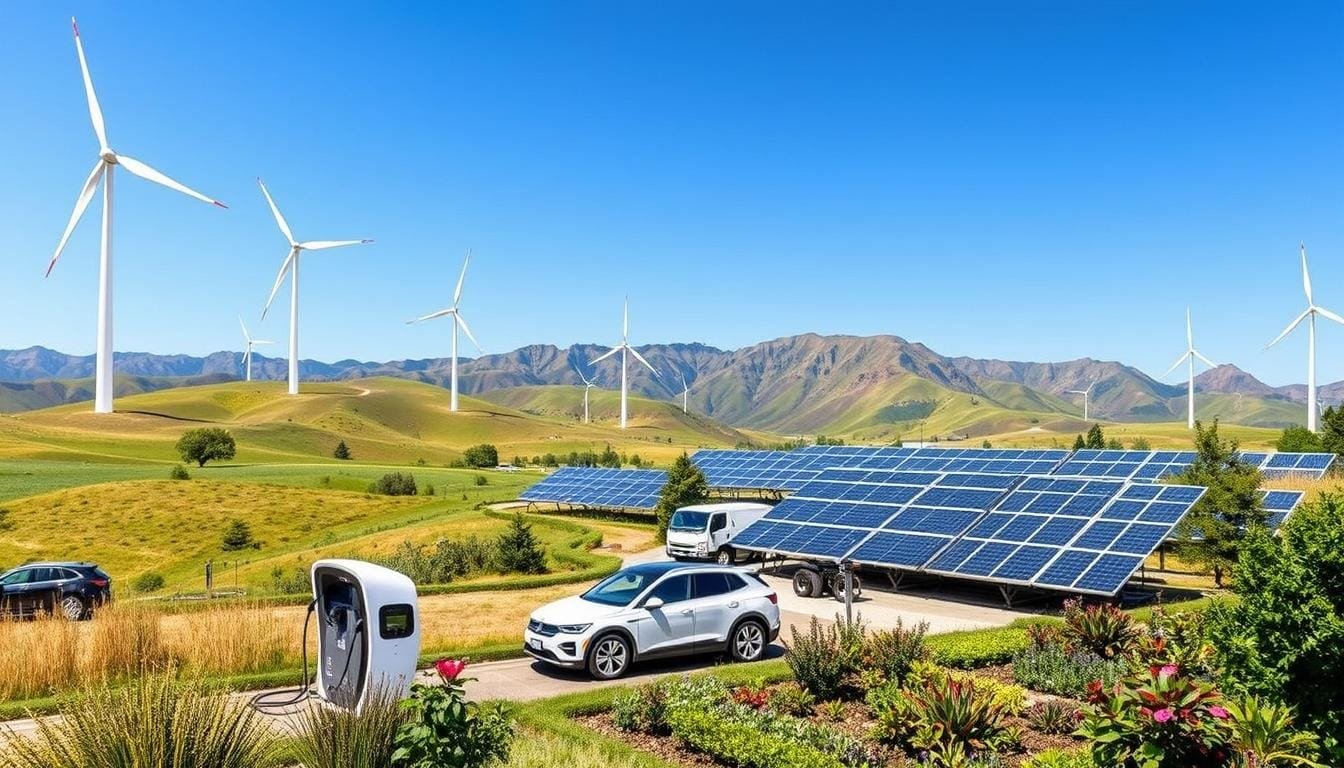The United States is making a big move, investing $16 billion in climate tech this year. This marks a new era for renewable power and sustainable electricity. The green energy news is changing fast, with new technologies leading the way in clean energy.
Microsoft’s Climate Innovation Fund is putting in $1 billion for climate tech. This shows the big push in the sustainable energy field. Big investors and tech leaders see green hydrogen and large-scale renewable energy as key to solving global climate issues.
Traditional oil companies are facing more pressure to switch to sustainable energy. The market is pushing for cleaner options. We’re seeing more deals in wind, solar, and energy storage, showing a strong move towards cleaner energy.
Key Takeaways
- $16 billion invested in climate tech this year
- Microsoft commits $1 billion to climate innovations
- Green hydrogen emerging as a significant energy player
- Increased scrutiny on traditional oil companies
- Growing investment in renewable energy infrastructure
Breaking Green Energy News: Revolutionary Solar Cell Efficiency Breakthrough
The world of green energy has seen a big change with new perovskite solar cell tech. Scientists have found a way to make solar power much more efficient. This is a huge step forward in clean energy.
Latest Perovskite Research Developments
Researchers at Oxford University have made a huge leap in solar tech. They’ve created a thin perovskite material that converts energy very well:
- Energy efficiency is now over 27%
- The material is just one micron thick – much thinner than old silicon wafers
- It performs as well as traditional silicon photovoltaics
Impact on Commercial Solar Applications
This new tech could change solar panels for the better. It could make them cheaper and more efficient. Here’s how it compares:
| Solar Technology | Energy Efficiency | Thickness |
|---|---|---|
| Traditional Silicon Panels | 22% | 150 microns |
| Perovskite Tandem Cells | 27-32.5% | 1 micron |
Future Market Implications
The solar market is on the verge of a big change. Solar costs have dropped by almost 90% in 10 years. This could make renewable energy more popular.
“We are witnessing a quantum leap in solar technology that could redefine our approach to sustainable energy production.” – Oxford PV Research Team
With companies like Oxford PV starting big production in Germany, the future of green energy looks good.
Sustainable Aviation: Hydrogen-Powered Flight Innovations
The aviation industry is at a turning point. It’s looking to use environmentally friendly power. Hydrogen is seen as a key player in making air travel greener.
“The future of aviation lies in clean energy solutions that protect our planet while maintaining technological innovation.” – Aviation Sustainability Research Center
Scientists are looking into hydrogen as a clean fuel for planes. It has big advantages over regular jet fuel:
- Zero carbon emissions during combustion
- High energy density compared to conventional fuels
- Potential for significant environmental impact reduction
But, there are big hurdles to overcome. We need better infrastructure and safety rules for hydrogen planes. Aerospace engineers are working hard to find solutions.
| Hydrogen Aviation Metrics | Current Status | Future Projection |
|---|---|---|
| Emission Reduction | 0% | 100% Possible |
| Research Investment | $500 Million | $2 Billion by 2030 |
| Prototype Development | Early Stage | Ready for Market |
Big names in aerospace are pouring money into hydrogen plane projects. Alternative energy advancements are moving fast. This means a bright future for flying green.
Battery Recycling Breakthrough: Citric Acid Solution
Green electricity trends are seeing a big change in battery recycling. A new innovation could change how we recycle lithium-ion batteries. It uses a clever citric acid solution.
Environmental Benefits of New Recycling Method
The citric acid method is great for the environment. It shows amazing results in recycling batteries:
- Over 99% recovery of lithium, nickel, cobalt, and manganese
- Significantly reduced CO2 emissions compared to traditional processes
- Minimized chemical usage and energy consumption
Cost-Effective Implementation Strategies
This breakthrough is good for both the planet and our wallets. It makes recycling batteries fast and efficient. Now, it only takes one hour.
| Metric | Traditional Method | Citric Acid Method |
|---|---|---|
| Recovery Rate | 70-80% | 99% |
| Processing Time | 10-12 hours | 1 hour |
| CO2 Emissions | High | Significantly Reduced |
Industry Impact Assessment
Experts think this method will be used a lot in two to three years. It could change battery recycling in renewable energy. Citric acid’s sustainable sourcing and safety make it great for many uses.
“This method represents a quantum leap in sustainable battery recycling technology.” – Renewable Energy Research Institute
Revolutionary Wind Energy Developments in America

The United States is going through a big change in renewable energy. Offshore wind energy is becoming a key part of our clean energy future. The Revolution Wind project is a big step forward in America’s clean energy journey. It shows huge progress in wind technology.
Wind energy is changing the renewable energy world:
- First multi-state offshore wind project in America
- 400 megawatts capacity for Rhode Island
- 304 megawatts capacity for Connecticut
- Powering over 350,000 homes
“Revolution Wind is not just an energy project; it’s an economic catalyst for sustainable development” – Clean Energy Expert
The project is a big deal for jobs and the economy. It will create 1,200 jobs and bring in big investments at State Pier and ProvPort. This shows how renewable energy can boost the economy.
| Project Milestone | Details |
|---|---|
| Turbine Technology | 65 Siemens Gamesa 11-megawatt turbines |
| Construction Timeline | Started 2023, Expected Operational by 2026 |
| Offshore Distance | 15 miles from Rhode Island coast, 32 miles from Connecticut coast |
The Revolution Wind project shows America’s dedication to clean energy. By using the latest technology and making smart investments, the United States is leading the way in renewable energy.
Artificial Photosynthesis: Hydrogel Technology Advancement
Scientists are exploring new ways to make energy with eco-friendly methods. They are working on artificial photosynthesis at the Japan Advanced Institute of Science and Technology (JAIST) and the University of Tokyo. They’ve made a hydrogel that works like nature’s energy process.
This hydrogel is a big step forward in renewable energy. It uses sunlight to break down water into hydrogen and oxygen. This is similar to how plants make energy from sunlight.
Scientific Breakthrough Details
The hydrogel technology has some key features:
- Structured polymer networks enhance electron transfer
- Prevents functional molecule aggregation
- Uses direct sunlight for hydrogen production
- Includes ruthenium complexes and platinum nanoparticles
Environmental Applications
“Our hydrogel technology represents a significant step toward sustainable energy production,” says lead researcher Dr. Kenji Yamamoto.
This technology could greatly help the environment. It could reduce our need for fossil fuels and lower carbon emissions. It could also change how many industries work.
Commercial Potencial
| Industry Sector | Potential Application |
|---|---|
| Transportation | Hydrogen fuel cell vehicles |
| Energy Storage | Renewable hydrogen generation |
| Manufacturing | Clean industrial processes |
The technology is not yet ready for use, but it’s getting closer. The team published their findings in Chemical Communications. This shows a bright future for artificial photosynthesis in making sustainable energy.
Clean Energy Grid Resilience: Lower Blackout Intensity Study

The world of clean energy is changing fast, showing us new ways to use green electricity. A recent study found something surprising about power grid resilience. It shows that renewable energy might be more stable than we thought.
Studies have found that power grids with more renewable energy have fewer and less severe blackouts. This finding changes how we think about keeping the power on.
“Grid resilience is no longer a limitation but an emerging strength of renewable energy systems.” – Energy Research Institute
Grid Resilience Factors
- Distributed nature of renewable energy sources
- Advanced grid management technologies
- Improved energy storage solutions
- Smart grid innovations
Numbers show a big change. In 2020-2021, people in the US lost power for an average of eight hours. This is more than double the time from 2013-2016. Also, over 90% of power outages happen in the distribution grid.
| Utility Company | Distribution SAIDI Percentage (2022) | Interruption Minutes |
|---|---|---|
| PG&E | 84.7% | 283.9 |
| SDG&E | 98.7% | 70.39 |
| SCE | 99.1% | 131.13 |
The data shows a detailed view of how well the grid works. It shows that clean energy can make our power systems more reliable.
Innovative Biofuel Technologies: Ultra-Clean Combustion Methods
Alternative energy advancements are changing how we make electricity. Baylor University has created a new Swirl Burst (SB) injector. It’s set to change how we burn biofuels.
Swirl Burst Injector Technology Breakthrough
The Swirl Burst injector is a big step forward in biofuel burning. It has achieved:
- Over 90% combustion efficiency across tested fuel blends
- Complete combustion with a 50/50 glycerol/methanol blend
- Near-zero emissions of carbon monoxide and nitrogen oxides
Emission Reduction Capabilities
Traditional injectors have trouble with thick fuels. But the SB injector fixes this. It eliminates expensive fuel preheating and processing, making biofuel cheaper to make. It also turns waste glycerol into clean energy.
“Our research shows we can turn bio-waste into clean, efficient energy,” says the Baylor team.
Implementation Timeline
The research is getting ready for the market. It’s backed by the NSF National I-Corps program. With a $1 million grant and support from the Biden administration, it’s set to make a big difference.
This new way of burning biofuels is a big step toward a cleaner future. It’s all about making our energy more sustainable and green.
Solar-Powered Desalination: Battery-Free Innovation
New eco-friendly energy solutions are changing how we purify water. A groundbreaking solar-powered desalination system is leading the way. It produces a lot of water without needing batteries.
Scientists have made a system that uses 94% of solar energy. This amazing technology can make up to 5,000 liters of clean water every day. It helps solve water shortages in places far from water sources.
“Our goal is to provide sustainable drinking water solutions for communities far from traditional water sources,” said lead research scientist.
Key Features of the Solar-Powered Desalination System:
- Produces 5,000 liters of clean water per day
- Harnesses 94% of solar panel electrical energy
- Eliminates battery storage requirements
- Adapts desalination rates 3-5 times per second
- Designed to serve communities of 3,000 people
The system was tested at the Brackish Groundwater National Desalination Research Facility in New Mexico. It works with brackish groundwater, which is common in many areas.
This technology is a big step forward in making water. It uses less battery and more solar energy. It offers affordable drinking water for areas with salty groundwater.
Tribal Nations and Offshore Wind Energy Partnership
The U.S. Department of Energy is leading a new partnership with Tribal Nations in offshore wind energy. This move is a big step towards using clean energy and helping indigenous communities.
The program, called the Capacity Accelerator for Tribal Offshore Wind Engagement, has a $7.1 million investment. It aims to change how Tribal Nations are involved in clean energy decisions.
Development Initiatives
Key strategies for development include:
- Technical assistance resources
- Knowledge-sharing opportunities
- Staff training and capacity building
- Economic development support
Community Impact Assessment
The program has three main phases to increase Tribal involvement:
- Capacity Needs Assessment
- Capacity Development
- Active Engagement
“This initiative represents a significant step towards inclusive and equitable renewable energy development” – U.S. Department of Energy Representative
Future Expansion Plans
Offshore wind power is showing great promise:
- 174 megawatts currently operational
- 25,116 megawatts under active development
- Multiple funding cycles planned through 2027
This partnership combines Traditional Ecological Knowledge with modern clean energy. It’s set to change America’s renewable energy scene.
Green Energy Investment Trends and Government Initiatives

The green energy news is booming, with a focus on clean power technologies. In 2024, renewable energy is leading the way, making up almost 90% of new projects. This is a big change.
“Clean energy investment is reshaping the global energy ecosystem, with unprecedented momentum and financial commitment,” says energy analyst Sarah Richardson.
Some key investment points include:
- Solar capacity grew by 88% to 18.6 gigawatts
- Battery storage increased by 64% to 7.4 GW
- Cleantech investment hit a record $71 billion in Q3 2024
Government support is key in making green energy more common. The Greenhouse Gas Reduction Fund has $27 billion to help. It aims to boost over 36 GW of clean energy by 2030.
| Investment Category | 2024 Projection |
|---|---|
| Global Clean Energy Investment | $2 trillion |
| US Clean Energy Investment | $315 billion |
| Battery Storage Investment | $54 billion |
More than two-thirds of industry leaders see a big role for government policies. They believe these policies are key to the energy shift.
The future of green energy is bright. With ongoing investment and support, we can see more innovation and growth.
Climate Change Impact on Grid Decarbonization Costs
The journey to clean energy is getting harder because of climate change. Studies show we face big hurdles in making our grid zero emissions by 2050. This shows how changes in the environment affect our energy systems.
Infrastructure Investment Requirements
We need to rethink our energy systems because of green trends. The Western Interconnection might have to add 139 GW of power by 2050. That’s almost three times California’s highest demand.
- Adapting to climate change could cost up to $150 billion more
- More investment means a 7% increase in costs
- Warmer temperatures will cut down on how much power we can send
Timeline to Zero Emissions
The U.S. power sector is a big source of greenhouse gas emissions. By 2024, wind and solar will beat coal for the first time. This is a big step towards clean energy.
The Biden Administration wants to make all electricity carbon-free by 2030.
Economic Implications
| Investment Area | Funding Allocated | Impact |
|---|---|---|
| Grid Resilience Projects | $3.46 billion | 58 projects across 44 states |
| Transmission Lines | $1.3 billion | Affecting 6 states |
| Rural Energy Programs | $375 million | Clean energy deployment |
The Infrastructure Investment and Jobs Act and Inflation Reduction Act are key. They will help meet our clean energy needs. This could cut greenhouse gas emissions by 300-400 million tons by 2035.
Carbon Emission Conversion Technology
Clean energy innovations are changing fast with new carbon emission conversion technologies. The U.S. Department of Energy is leading big zero-emission power plans. These plans aim to change how we deal with and use carbon dioxide.
“We are turning carbon emissions from a problem into a solution for sustainable energy production.”
The government is putting a lot of money into these technologies. They’ve set aside $13.7 million for four key carbon conversion projects. These projects focus on different areas:
- Aviation fuel aiming for 100% net-zero emissions by 2050
- Maritime, rail, and off-road fuel for 50% net-zero emissions
- Carbon-based chemicals for 50% net-zero emissions
New technologies are being tested to turn carbon emissions into something useful. These include:
- Electrochemical conversion systems
- Molten salt-based capture technologies
- Hydrogen sulfide reforming for methanol production
The National Energy Technology Laboratory (NETL) is leading these projects. They’re working on making carbon dioxide conversion at 10 tonnes per day. This could lead to making algae biomass and turning CO2 into valuable fuels and products.
| Technology Area | Conversion Focus | Scale Target |
|---|---|---|
| Biological Conversion | Algae Biomass | 10 tonnes/day |
| Catalytic Conversion | Fuel Production | Pilot Scale |
| Mineralization | Carbon Transformation | 10 tonnes/day |
This new approach shows the United States’ dedication to making carbon emissions into a sustainable energy source.
Conclusion
The clean energy scene in the United States is changing fast. By 2030, we’ll see big changes in how we make and use energy. Renewables will likely make up 80% of new power plants.
Electric cars are expected to grow a lot, possibly by nearly ten times. Solar and wind power will also get cheaper and work better.
Looking at the economy, green energy looks good. Investments in clean energy have jumped 71% after the Inflation Reduction Act. This created 142,000 jobs in 2023.
The International Energy Agency says we’ll see 30 million more clean energy jobs by 2030. These jobs pay 19% more than average. Plus, they offer stable careers and chances to join unions.
Switching to renewable energy is good for the planet and the economy. Homes could save $2,000 a year by 2035. The total savings could reach $12 trillion by 2050.
With technology getting better, green energy is a key moment for America’s future. It’s about saving money, creating jobs, and building a strong energy system for the next generation.

